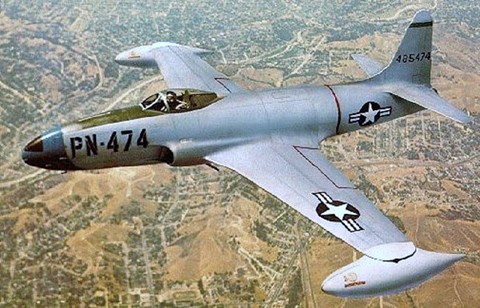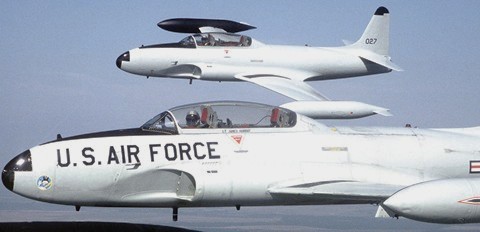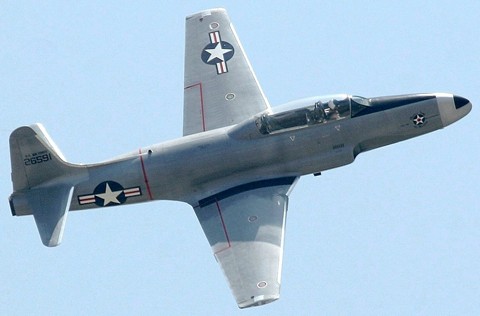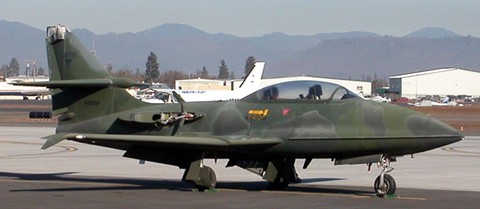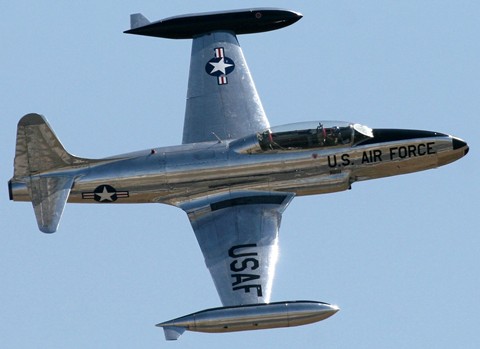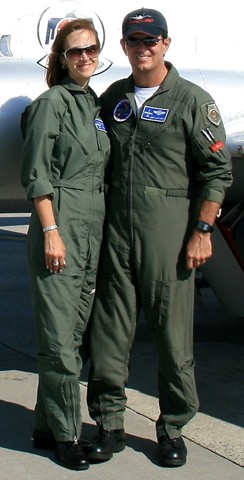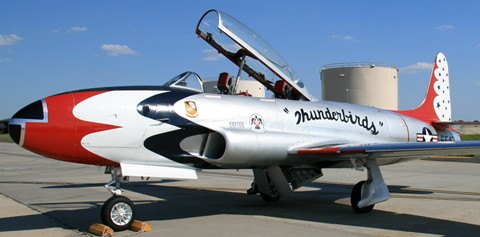|
T-33 Shooting StarThe T-33 trainer evolved from the P-80. Both were named the Shooting Star. BackgroundIn World War II, Allied intelligence discovered that Germany had a jet fighter, the ME-262. This prompted the US Army Air Force (USAAF) to come up with its first operational jet fighter. That aircraft became the Lockheed P-80 Shooting Star. The Air Force would later drop all P-designations (Pursuit) in lieu of F-designations (Fighter). Thus, the P-80 became the F-80 Shooting Star. Photo below shows the Lockheed P-80A Shooting Star (44-85474). Photo courtesy of USAF. To our knowledge, this aircraft no longer exists.
As the F-80 became the first operational jet for the USAAF, the demand for a two-seat trainer version grew. A prototype TF-80C (48-0356) was built that was three feet longer than the F-80. This aircraft now lives as a gate guard at Lackland AFB, San Antonio, TX. When production for the two-seat trainer began, the designation was changed to T-33A. Thus began a long tenure for the Shooting Star, which was produced from 1948-1959 to the tune of 6,557 aircraft built. In fact, it was produced in more numbers than its predecessor (P-80/F-80) with 1,715 F-80s built.
A pair of Shooting Stars is shown in the above photo, courtesy of the USAF. Bureau number for the foreground aircraft is 57-0711, which at the time was assigned to the 95th Fighter Interceptor Squadron, Tyndall AFB, FL. The aircraft in the background, had been recently repainted in anticipation for transfer to the Mexican air force, so its bureau number is unknown. VariantsAs more advanced jets entered service, the jet trainer took on the role of training jet pilots who were already qualified to fly propeller-driven aircraft. Starting in 1949, the US Navy used the aircraft as a land-based trainer. It was designated the TV-2, but was redesignated the T-33B in 1962. See photo below of a TV-2 (126591, NX6633D) sans wing tanks, owned by the Planes of Fame Museum, Chino, CA.
The Navy also operated some ex-USAF P-80Cs as the TO-1, but the model number changed to TV-1 about a year later. A carrier-capable version of the Shooting Star family was developed by Lockheed as the T2V-1, which was later designated T-1A SeaStar. It served from the late 1950s to the 1970s. The T-33 proved not only to be a suitable advanced trainer, but it has been used for such tasks as drone director and target towing, while some retained two machine guns for gunnery training. In some countries, it was even employed as a combat aircraft. The RT-33A version reconnaissance aircraft was produced primarily for use by foreign countries. It had a camera installed in the nose and additional equipment in the rear cockpit. End of the LineThe aircraft continued to fly as trainers, combat and tactical simulation training, electronic countermeasures and warfare training, and test platforms right into the 1980s. They were also used as "hack" aircraft, which are aircraft that perform duties they were not intended for. For example, many foreign countries used T-33s as cargo planes, liaison aircraft, and as ferries to chauffeur dignitaries around. In the US, they became drone towing planes, and eventually, drones themselves, such as the QT-33A. SkyfoxBy the 1980s, a more modern training aircraft was needed. Shooting Star designer Irvin Culver and a number of other former Lockheed employees formed Flight Concepts Incorporated in 1982, with the intent of modernizing the aging design into a modern twin-engine aircraft. The company's name was later changed to Skyfox Corporation. Besides its primary role as a trainer, the aircraft was envisioned to have other roles as well, including ground attack. The highly modified aircraft was expected to cost about half of a new comparable trainer, such as the British Aerospace BAE Hawk and the Dassault-Breguet/Dornier Alpha Jet. With the design work done, Skyfox purchased 80 surplus T-33s. The first one converted was an ex-Canadian Forces CT-133 Silver Star (the Canadian license-built equivalent of the T-33). After conversion to the Skyfox configuration, the first flight was performed on August 23, 1983 by renowned race pilot Skip Holm at the Mojave Airport. Skyfox Corp was not able to find any buyers for the aircraft, despite its price and capability. In 1986, Boeing saw potential, and purchased the marketing and production rights. Boeing marketed the Skyfox as a complete converted aircraft built by Boeing, or as a conversion kit, with the customer providing the airframe. The conversion incorporated about 70% of the existing T-33 airframe, but replaced the existing internal single Allison J33 turbojet engine with two Garrett TFE731-3A turbofan engines mounted externally. Together, the two TFE731s weighed 17% less than the single original engine, provided 60% more thrust on 45% less fuel. Changing engines provided a large internal volume for fuel storage, eliminating the need for the wing tip tanks (although the wing tip mountings were retained to provide for optional auxiliary fuel tanks if desired). The Skyfox used an aerodynamically improved nose and tail, although the original wings were retained. Though Portugal signed a letter of intent for 20 conversion kits, no other nation signed on. Faced with a lack of customers, Boeing cancelled the project. The prototype aircraft (21160, N221SF) remains the only Skyfox built. See public domain photo below. To our knowledge, the aircraft is still airworthy.
LongevityThe T-33 has served with over 30 nations, and continues to operate as a trainer in smaller air forces. Canadair built 656 T-33s on license for service in the Canadian Forces as the CT-133 Silver Star while Kawasaki manufactured 210 in Japan. Other operators included Brazil, Turkey and Thailand. Many T-33s (and CT-133s) still fly in the US as warbirds at air shows such as the CT-133 Silver Star Mk. III (T-33-129, NX84TB) shown below.
Our favorite Shooting Star is this absolutely beautiful T-33A (58-665, NX556RH) in Thunderbird markings. It is owned by Fowler 'Big Dog' Cary and flown by Jerry ‘Jive’ Kerby. Photo below by Howard German.
Jerry's commentator (and now his wife) is the lovely LM ‘Lunar’ Sawyer. I promised Lunar I would not say what the LM stands for. If you have a chance to see this awesome aircraft, please do so. Photos below taken by Horace Sagnor.
Navigation IndexReturn to the top of this T-33 page.
|
